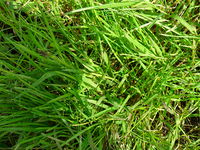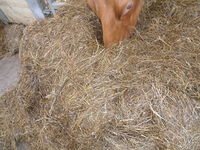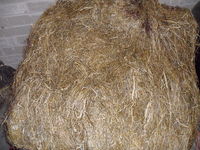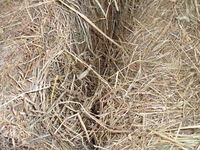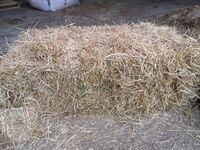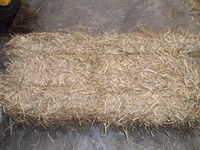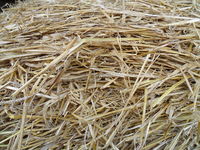Difference between revisions of "Forage"
| (32 intermediate revisions by 3 users not shown) | |||
| Line 1: | Line 1: | ||
| − | ==Grass== | + | ==Grass== |
| − | + | [[File:Grasshastie.jpg|Grass|200px]] | |
| − | ===Characteristics=== | + | ===Characteristics=== |
| − | |||
Typically based on ryegrass, but often mixed swards with cocksfoot, fescues, timothy, and legumes (e.g. clover). It is present in rough/hill grazing (often with heather, rushes, mosses), permanent pasture and rotational leys, the latter often high yielding italian or perennial ryegrass monocultures. | Typically based on ryegrass, but often mixed swards with cocksfoot, fescues, timothy, and legumes (e.g. clover). It is present in rough/hill grazing (often with heather, rushes, mosses), permanent pasture and rotational leys, the latter often high yielding italian or perennial ryegrass monocultures. | ||
<br> | <br> | ||
| Line 16: | Line 15: | ||
<br> | <br> | ||
===Associated Problems===<!----Write below this line---> | ===Associated Problems===<!----Write below this line---> | ||
| − | + | ||
Scours, hypomagnesaemic tetany (especially in winter, or in rapidly growing grass (e.g. spring,/early summer, late summer/autumn), bloat (especially as mixed legume swards), pasture-induced laminitis. | Scours, hypomagnesaemic tetany (especially in winter, or in rapidly growing grass (e.g. spring,/early summer, late summer/autumn), bloat (especially as mixed legume swards), pasture-induced laminitis. | ||
<br><br><br> | <br><br><br> | ||
==Silage and Haylage== <!----Write below this line---> | ==Silage and Haylage== <!----Write below this line---> | ||
| − | + | [[File:Big bale silage2.jpg|Silage|200px]] | |
| + | [[File:Big bale silage.jpg|Big Bale Silage|200px]] | ||
===Characteristics===<!----Write below this line---> | ===Characteristics===<!----Write below this line---> | ||
Silage is a fermented crop with a low dry matter content. It is cut at a relatively early stage of development and stored under anaerobic conditions (clamp or big bale). Haylage is similar to silage but is often cut at a more mature stage and is typically baled. Haylage has a higher pH and DM than silage and can often be of more variable quality. With horses haylage is typically preferred (by owners) to silage. | Silage is a fermented crop with a low dry matter content. It is cut at a relatively early stage of development and stored under anaerobic conditions (clamp or big bale). Haylage is similar to silage but is often cut at a more mature stage and is typically baled. Haylage has a higher pH and DM than silage and can often be of more variable quality. With horses haylage is typically preferred (by owners) to silage. | ||
| Line 33: | Line 33: | ||
|Haylage || 50-60 || 9 - 11.5 || 75 - 110 || 4.5 - 5.5 | |Haylage || 50-60 || 9 - 11.5 || 75 - 110 || 4.5 - 5.5 | ||
|} | |} | ||
| − | + | <br> | |
===Associated Problems===<!----Write below this line---> | ===Associated Problems===<!----Write below this line---> | ||
| Line 40: | Line 40: | ||
==Hay== <!----Write below this line---> | ==Hay== <!----Write below this line---> | ||
| − | + | [[File:Hayhastie.jpg|Hay|200px]] | |
| + | [[File:Hay3.jpg|Hay|200px]] | ||
===Characteristics===<!----Write below this line---> | ===Characteristics===<!----Write below this line---> | ||
| + | Hay is dried grass, either naturally or artificially (dependent on the weather). It is cut at a relatively late stage of maturity and is typically of variable quality in colour and smell, and nutritive value. There are various types of hay such as ryegrass, meadow, and timothy. <br> | ||
| + | {| class="wikitable" | ||
| + | |- | ||
| + | ! !! DM (%) !! ME (MJ/kg DM) !! CP (g/kg DM) | ||
| + | |- | ||
| + | |Hay || 80 - 90 || 7.5 - 10.5 ||50 - 150 | ||
| + | |} | ||
<br> | <br> | ||
| − | |||
| − | |||
| − | |||
| − | |||
===Associated Problems===<!----Write below this line---> | ===Associated Problems===<!----Write below this line---> | ||
| − | |||
Moulds/mycotoxins. | Moulds/mycotoxins. | ||
| − | <br><br><br> | + | <br><br><br> |
| + | |||
==Straw== <!----Write below this line---> | ==Straw== <!----Write below this line---> | ||
| − | + | [[File:Straw1.jpg|200px]] | |
| + | [[File:Straw4.jpg|200px]] | ||
===Characteristics===<!----Write below this line---> | ===Characteristics===<!----Write below this line---> | ||
| + | Straw (usually barley or oat for feed) can be treated with alkali, urea or ammonia. It is commonly used as a roughage source for growing ruminants, and especially animals being reared in cereal beef systems. | ||
<br> | <br> | ||
| − | Straw ( | + | {| class="wikitable" |
| + | |- | ||
| + | ! !! DM (%) !! ME (MJ/kg DM) !! CP (g/kg DM) | ||
| + | |- | ||
| + | |Straw || 86 - 88 || 6.1 - 7 || 34 - 38 | ||
| + | |- | ||
| + | |Straw (ammoniated)|| 84 - 88 || 7.4 - 7.8 || 68 - 75 | ||
| + | |} | ||
<br> | <br> | ||
| − | |||
| − | |||
| − | |||
| − | |||
===Associated Problems===<!----Write below this line---> | ===Associated Problems===<!----Write below this line---> | ||
| − | |||
Moulds/mycotoxin. Impaction within GI tract (especially horses). High intakes of straw (+ grains) are associated with hypomagnesaemic tetany (due to high K levels in grain and straw) | Moulds/mycotoxin. Impaction within GI tract (especially horses). High intakes of straw (+ grains) are associated with hypomagnesaemic tetany (due to high K levels in grain and straw) | ||
| − | <br><br><br> | + | <br><br><br> |
| + | |||
==Whole-Crop Cereal Silage== <!----Write below this line---> | ==Whole-Crop Cereal Silage== <!----Write below this line---> | ||
| + | [[File:Near Knaps of Bedlam - geograph.org.uk - 1304243.jpg|200px]] | ||
| + | ===Characteristics===<!----Write below this line---> | ||
| + | Maize whole-crop silage has high energy concentration while having a low protein concentration. It is harvested when grain is in the late dough stage. Barley, oats, wheat, and triticale are also used for whole-crop cereal silage either as monocultures or mixed with legumes (e.g. peas) to improve protein content. They are also high in energy while low in protein. Whole-crop cereal silages are fed as sole forage or mixed with grass silage. | ||
<br> | <br> | ||
| + | {| class="wikitable" | ||
| + | |- | ||
| + | ! !! DM (%) !! ME (MJ/kg DM) !! CP (g/kg DM) | ||
| + | |- | ||
| + | |Maize whole-crop silage || 22 - 35 || 10.5 - 12 ||65 - 110 | ||
| + | |- | ||
| + | |Barley whole-crop silage || 30 - 40 ||9 - 11 ||80 - 110 | ||
| + | |} | ||
| + | <br> | ||
| + | ===Associated Problems===<!----Write below this line---> | ||
| + | Clostridia. Listeriosis. Acidosis. Poor fermentation (pH > 4.8) or too acidic (pH < 3.8). | ||
| + | |||
| + | ==Clovers and Lucerne== | ||
| + | [[File:Clover.jpg|Red clover|200px]] | ||
| + | [[File:White Clover(Trifolium repens).jpg|White Clover|200px]] | ||
| + | [[File:Lucerne flowers.jpg|Lucerne|200px]] | ||
===Characteristics===<!----Write below this line---> | ===Characteristics===<!----Write below this line---> | ||
| + | Clovers are either white or red varieties. Clovers and Lucerne (aka Alfalfa) have a higher protein concentration and a higher mineral concentration (e.g. calcium) than grasses. Lucerne can be grazed or conserved as a monoculture. Lucernes also have a higher protein concentration than grasses. Lucerne silages tend to be more difficult to achieve a good fermentation, inoculants are usually required. | ||
<br> | <br> | ||
| − | + | {| class="wikitable" | |
| + | |- | ||
| + | ! !! DM (%) !! ME (MJ/kg DM) !! CP (g/kg DM) | ||
| + | |- | ||
| + | |Clover || 18 - 20 || 9 - 10.5 || 170 - 250 | ||
| + | |- | ||
| + | |Lucerne || 22 - 25 || 8 - 10.5 || 150 - 200 | ||
| + | |- | ||
| + | |Lucerne Hay || 84 - 88 || 8 - 10.5 || 200 - 225 | ||
| + | |} | ||
<br> | <br> | ||
| − | |||
| − | |||
| − | |||
| − | |||
===Associated Problems===<!----Write below this line---> | ===Associated Problems===<!----Write below this line---> | ||
| + | |||
| + | Bloat (frothy). Red clovers and some Lucerne varieties may also contain significant levels of phytoestrogens that cause subfertility. | ||
| + | <br><br><br> | ||
| + | |||
| + | ==Kale and Rape== | ||
| + | [[File:Kale1.jpg||200px|Kale]] | ||
| + | ===Characteristics=== | ||
| + | Kale and rape are considered good, digestible fodder. They have a higher protein concentration, carbohydrate concentration and calcium concentration than grasses. Rape has a higher protein concentration than kale. | ||
<br> | <br> | ||
| − | + | {| class="wikitable" | |
| + | |- | ||
| + | ! !! DM (%) !! ME (MJ/kg DM) !! CP (g/kg DM) | ||
| + | |- | ||
| + | |Kale || 14 || 11 || 160 | ||
| + | |- | ||
| + | |Rape || 14 || 9.5 || 200 | ||
| + | |} | ||
| + | <br> | ||
| + | ===Associated Problems=== | ||
| + | Goitrogenic. Haemolytic anaemia, haemoglobinuria. Feed to pregnant ewes with caution (can observe malformed, dead lambs at parturition). | ||
| + | <br><br><br> | ||
| + | {{Learning | ||
| + | |flashcards = [[Large Animal Nutrition Flashcards]] | ||
| + | }} | ||
| + | |||
| + | [[Category:Large Animal Nutrition]] | ||
| + | [[Category:To Do]] | ||
Latest revision as of 09:20, 27 October 2015
Grass
Characteristics
Typically based on ryegrass, but often mixed swards with cocksfoot, fescues, timothy, and legumes (e.g. clover). It is present in rough/hill grazing (often with heather, rushes, mosses), permanent pasture and rotational leys, the latter often high yielding italian or perennial ryegrass monocultures.
| DM (%) | ME (MJ/kg DM) | CP (g/kg DM) | |
|---|---|---|---|
| Grass (young) | 15 - 20 | 11.5 - 12.5 | 150 - 250 |
| Grass (mature) | 25 - 50 | 9.5 - 10.5 | 50 - 130 |
Associated Problems
Scours, hypomagnesaemic tetany (especially in winter, or in rapidly growing grass (e.g. spring,/early summer, late summer/autumn), bloat (especially as mixed legume swards), pasture-induced laminitis.
Silage and Haylage
Characteristics
Silage is a fermented crop with a low dry matter content. It is cut at a relatively early stage of development and stored under anaerobic conditions (clamp or big bale). Haylage is similar to silage but is often cut at a more mature stage and is typically baled. Haylage has a higher pH and DM than silage and can often be of more variable quality. With horses haylage is typically preferred (by owners) to silage.
| DM (%) | ME (MJ/kg DM) | CP (g/kg DM) | pH | |
|---|---|---|---|---|
| Silage | 15 - 20 (20-30 clamp)(40-50 bale) | 9.5 - 12 | 120 - 190 | 3.8 - 4.8 |
| Haylage | 50-60 | 9 - 11.5 | 75 - 110 | 4.5 - 5.5 |
Associated Problems
Clostridia. Listeriosis. Acidosis. Moulds/mycotoxins. Poor fermentation (pH > 4.8) or too acidic (pH < 3.8).
Hay
Characteristics
Hay is dried grass, either naturally or artificially (dependent on the weather). It is cut at a relatively late stage of maturity and is typically of variable quality in colour and smell, and nutritive value. There are various types of hay such as ryegrass, meadow, and timothy.
| DM (%) | ME (MJ/kg DM) | CP (g/kg DM) | |
|---|---|---|---|
| Hay | 80 - 90 | 7.5 - 10.5 | 50 - 150 |
Associated Problems
Moulds/mycotoxins.
Straw
Characteristics
Straw (usually barley or oat for feed) can be treated with alkali, urea or ammonia. It is commonly used as a roughage source for growing ruminants, and especially animals being reared in cereal beef systems.
| DM (%) | ME (MJ/kg DM) | CP (g/kg DM) | |
|---|---|---|---|
| Straw | 86 - 88 | 6.1 - 7 | 34 - 38 |
| Straw (ammoniated) | 84 - 88 | 7.4 - 7.8 | 68 - 75 |
Associated Problems
Moulds/mycotoxin. Impaction within GI tract (especially horses). High intakes of straw (+ grains) are associated with hypomagnesaemic tetany (due to high K levels in grain and straw)
Whole-Crop Cereal Silage
Characteristics
Maize whole-crop silage has high energy concentration while having a low protein concentration. It is harvested when grain is in the late dough stage. Barley, oats, wheat, and triticale are also used for whole-crop cereal silage either as monocultures or mixed with legumes (e.g. peas) to improve protein content. They are also high in energy while low in protein. Whole-crop cereal silages are fed as sole forage or mixed with grass silage.
| DM (%) | ME (MJ/kg DM) | CP (g/kg DM) | |
|---|---|---|---|
| Maize whole-crop silage | 22 - 35 | 10.5 - 12 | 65 - 110 |
| Barley whole-crop silage | 30 - 40 | 9 - 11 | 80 - 110 |
Associated Problems
Clostridia. Listeriosis. Acidosis. Poor fermentation (pH > 4.8) or too acidic (pH < 3.8).
Clovers and Lucerne
Characteristics
Clovers are either white or red varieties. Clovers and Lucerne (aka Alfalfa) have a higher protein concentration and a higher mineral concentration (e.g. calcium) than grasses. Lucerne can be grazed or conserved as a monoculture. Lucernes also have a higher protein concentration than grasses. Lucerne silages tend to be more difficult to achieve a good fermentation, inoculants are usually required.
| DM (%) | ME (MJ/kg DM) | CP (g/kg DM) | |
|---|---|---|---|
| Clover | 18 - 20 | 9 - 10.5 | 170 - 250 |
| Lucerne | 22 - 25 | 8 - 10.5 | 150 - 200 |
| Lucerne Hay | 84 - 88 | 8 - 10.5 | 200 - 225 |
Associated Problems
Bloat (frothy). Red clovers and some Lucerne varieties may also contain significant levels of phytoestrogens that cause subfertility.
Kale and Rape
Characteristics
Kale and rape are considered good, digestible fodder. They have a higher protein concentration, carbohydrate concentration and calcium concentration than grasses. Rape has a higher protein concentration than kale.
| DM (%) | ME (MJ/kg DM) | CP (g/kg DM) | |
|---|---|---|---|
| Kale | 14 | 11 | 160 |
| Rape | 14 | 9.5 | 200 |
Associated Problems
Goitrogenic. Haemolytic anaemia, haemoglobinuria. Feed to pregnant ewes with caution (can observe malformed, dead lambs at parturition).
| Forage Learning Resources | |
|---|---|
 Test your knowledge using flashcard type questions |
Large Animal Nutrition Flashcards |
